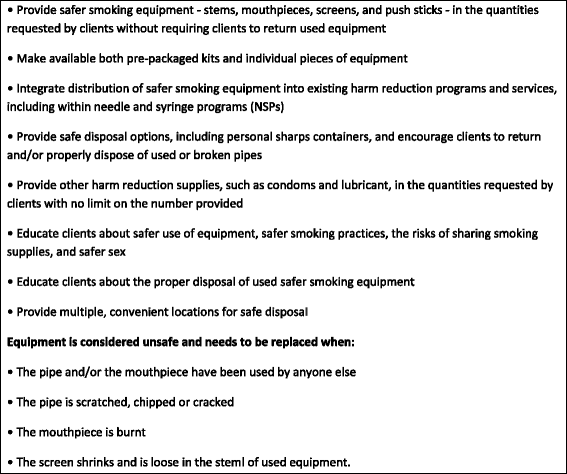Education and equipment for people who smoke crack cocaine in Canada: progress and limits
- PMID: 28494810
- PMCID: PMC5427547
- DOI: 10.1186/s12954-017-0144-3
Education and equipment for people who smoke crack cocaine in Canada: progress and limits
Abstract
Background: People who smoke crack cocaine experience a wide variety of health-related issues. However, public health programming designed for this population is limited, particularly in comparison with programming for people who inject drugs. Canadian best practice recommendations encourage needle and syringe programs (NSPs) to provide education about safer crack cocaine smoking practices, distribute safer smoking equipment, and provide options for safer disposal of used equipment.
Methods: We conducted an online survey of NSP managers across Canada to estimate the proportions of NSPs that provide education and distribute safer smoking equipment to people who smoke crack cocaine. We also assessed change in pipe distribution practices between 2008 and 2015 in the province of Ontario.
Results: Analysis of data from 80 programs showed that the majority (0.76) provided education to clients on reducing risks associated with sharing crack cocaine smoking equipment and about when to replace smoking equipment (0.78). The majority (0.64) also distributed safer crack cocaine smoking equipment and over half of these programs (0.55) had done so for less than 5 years. Among programs that distributed pipes, 0.92 distributed the recommended heat-resistant Pyrex and/or borosilicate glass pipes. Only 0.50 of our full sample reported that their program provides clients with containers for safer disposal of used smoking equipment. The most common reasons for not distributing safer smoking equipment were not enough funding (0.32) and lack of client demand (0.25). Ontario-specific sub-analyses showed a significant increase in the proportion of programs distributing pipes in Ontario from 0.15 (2008) to 0.71 (2015).
Conclusions: Our findings point to important efforts by Canadian NSPs to reduce harm among people who smoke crack cocaine through provision of education and equipment, but there are still limits that could be addressed. Our study can provide guidance for future cross-jurisdiction studies to describe relationships involving harm reduction programs and provision of safer crack cocaine smoking education and equipment.
Keywords: Best practice; Canada; Crack cocaine; Cross-sectional; Education; Needle and syringe program; Safer smoking.
Figures
References
-
- Fischer B, Rudzinski K, Ivsins A, Gallupe O, Patra J, Krajden M. Social, health and drug use characteristics of primary crack users in three mid-sized communities in British Columbia. Canada Drug-Educ Prev Polic. 2010;17:333–53. doi: 10.3109/09687630903357700. - DOI
-
- Porter J, Bonilla L, Drucker E. Methods of smoking crack as a potential risk factor for HIV infection: crack smokers’ perceptions and behavior. Contemp Drug Probl. 1997;24:319–47. doi: 10.1177/009145099702400207. - DOI
MeSH terms
Substances
LinkOut - more resources
Full Text Sources
Other Literature Sources
Medical


